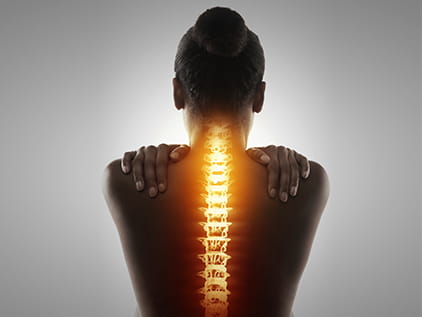May 17, 2019
Fred Bonadonna, doesn't spend a lot of time sitting around. As a professional barber, he's been standing for a living since 1967. After hours, he's active with golf, travel and family get-togethers.
But in 2015, physical activity became less appealing to Fred. He developed a sharp pain in his left leg, making work and golf challenging. Then, during a 2016 trip through Italy with his family, Fred struggled to keep up. He wasn't out of breath. His leg hurt.
"I just got tired of it," he says. "I went for MRIs and talked to different doctors. I learned the problem was in my spine, not my leg."
Several local healthcare providers gave Fred advice and treatment, but he did not get relief. In fact, his leg and back pain continued to worsen.
Then a customer asked if he had tried the spine center at The University of Kansas Health System. "That sounded interesting to me," says Fred.
Conservative approach
At the health system's Marc A. Asher, MD, Comprehensive Spine Center, patients have access to every type of spine specialist. The team includes physiatrists, neurologists, anesthesiologists, spine surgeons, physical therapists and more.
First, Fred met with anesthesiologist and pain management specialist Dawood Sayed, MD. He confirmed the diagnosis of isthmic spondyloisthesis, a condition in which one vertebra slips forward on the vertebrae below. This caused Fred significant instability and nerve compression in his spine.
After Dr. Sayed offered a conservative, nonsurgical procedure Fred did not yet find relief. So Dr. Sayed referred Fred to a colleague, orthopedic surgeon Joshua Bunch, MD.
Advanced spine care
"Our multidisciplinary team offers a wide variety of treatment options," says Dr. Bunch. "We start with conservative measures, such as physical therapy and injections. If those options fail to improve a patient's pain, we then consider surgery."
Dr. Bunch reviewed Fred's MRI and ordered additional X-rays.
"Isthmic spondylolisthesis can go undetected for many years," explains Dr. Bunch. "Leg and lower back pain are common symptoms. Fred also had significant narrowing around the nerves as they exit the spine, which also contributed to his pain."
To give Fred the best chance for success, Dr. Bunch recommended operating on his spine from both the front and back of his body. This first is called anterior lumbar interbody fusion. The second is posterior lumbar decompression and fusion.
Fred and his wife, Linda, were apprehensive, but also desperate for relief.
"I was tired of the aggravation. My leg hurt all the time," says Fred. "I wanted the surgery."
Surgery is teamwork
In February 2018, Fred was admitted to The University of Kansas Hospital. His surgery lasted 6 hours.
Vascular surgeon Kirk A. Hance, MD, made an incision in Fred's abdomen to allow Dr. Bunch to access the spine from the front. After finishing the procedure on the front of the spine, Dr. Bunch made an incision in Fred's back. A cage, or spacer, was placed in the front to take the pressure off Fred's nerve roots and restore his spinal alignment. His spine was also stabilized from the back with screws and rods to fuse the two vertebrae together and make his spine more stable.
"I was very pleased with Dr. Bunch and the whole staff," Fred says. "They were very kind to me at the hospital."
Recovery time
After spine surgery, some patients need a great deal of rehabilitation therapy before they can leave the hospital. Not Fred. He was up on his feet almost immediately.
"Fred did really well from the get-go," says Dr. Bunch. "After a short stint of rehab to make sure he was safe on his feet, we were able to discharge him from the hospital."
For the next 7 weeks, Fred stayed home from work to recover. He followed Dr. Bunch's orders to maintain his mobility and walk within his home several times a day.
"He told me walking was the best rehab for me," says Fred.
In March, Fred returned to the spine center to have his stitches removed and new X-rays taken. Everything looked good.
"Fred is a model patient," says Dr. Bunch. "Part of a patient's long-term success rests with the surgeon, but it also rests with the patient. A lot of the credit goes to Fred. He did everything we asked him to do."
Fred returned to his barbershop, working half days for the first week. The following week, he went full-time. By May, Fred was doing even better.
"Dr. Bunch said I could go back to swinging a club," he recalls. "He said I could do anything I wanted, but not to overdo it. No heavy lifting."
Back in action
By summer, Fred and Linda were traveling again. The following Thanksgiving, they went to Palm Springs.
"I dance at weddings. I golf and work out at the gym," says Fred. "The leg pain is gone."
Dr. Bunch ways that Fred will likely have good days and bad, but this level of pain will be far better than it was before surgery.
"We think the world of Dr. Bunch. He's an excellent doctor," Linda says. "I always recommend him and the hospital to everyone I see."
Fred's advice for anyone with leg, back or neck pain? "Do what your doctor tells you," he says. "It's that simple."

Pain in the neck?
Experts at the Marc A. Asher, MD, Comprehensive Center offer many treatment options for spine and neck discomfort.
- Physical therapy
- Nonsteroidal, anti-inflammatory drugs
- Epidural steroid injections
- Radiofrequency ablation
- Surgery





